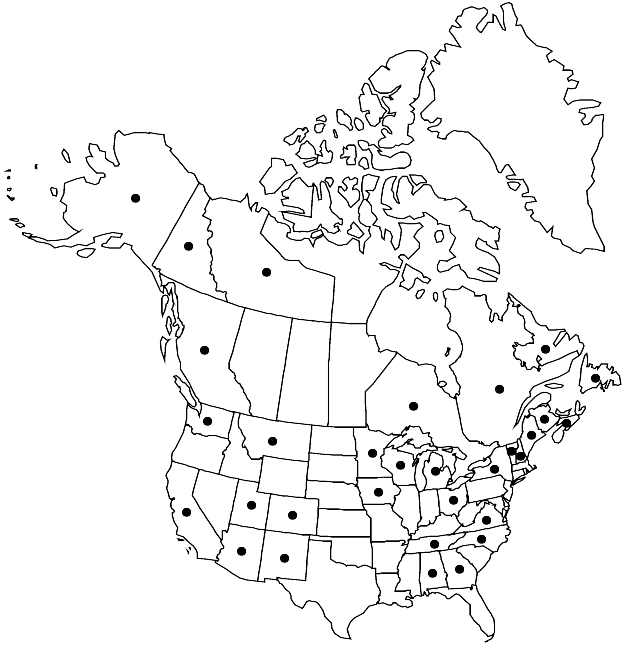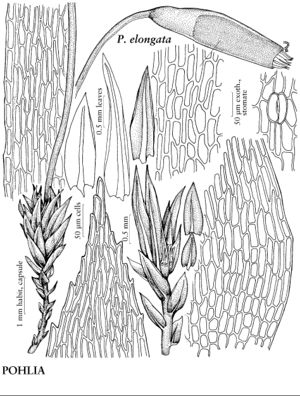Pohlia elongata
Sp. Musc. Frond., 171. 1801.
Plants small, green, dull. Stems 0.5–2.5 cm. Leaves erect to ± spreading, lanceolate to ovate-lanceolate, 2 mm; margins subentire or more often serrulate to serrate in distal 1/3; costa subpercurrent or percurrent; distal medial laminal cells hexagonal to rhomboidal, firm, 45–85 µm, walls moderately thick. Specialized asexual reproduction absent. Sexual condition paroicous, autoicous, or rarely dioicous; perigonial leaves in dioicous plants broadly short-ovate; perichaetial leaves somewhat differentiated, ± long-lanceolate. Seta orange to orange-brown. Capsule inclined 10–90°, stramineous, orange, or orange-brown, short- to long- and slender-pyriform, neck 1/2–1 time urn length; exothecial cells elongate-rectangular, walls straight; stomata superficial; annulus present; operculum conic; exostome teeth yellow to brown, acute-triangular; endostome hyaline, basal membrane barely exceeding capsule rim or to 1/3 exostome length, segments narrowly or not keeled, narrowly to not perforate, cilia absent to rudimentary, rarely long. Spores 16–23 µm, distinctly roughened.
Phenology: Capsules mature spring–summer (Apr–Jul).
Habitat: Humus-rich soil banks, along streams and paths, tree bases
Elevation: moderate to high elevations
Distribution

B.C., N.B., Nfld. and Labr., N.W.T., N.S., Ont., Que., Yukon, Ala., Alaska, Ariz., Calif., Colo., Ga., Iowa, Maine, Mich., Minn., Mont., N.H., N.Mex., N.Y., N.C., Ohio, Tenn., Utah, Vt., Va., Wash., Wis., Mexico, Central America, South America, Eurasia, Africa, Pacific Islands, Australia.
Discussion
Pohlia elongata is widespread in North America but not common. Plants generally occur scattered or in small patches and regularly produce sporophytes from bisexual (paroicous) gametophytes. The capsule necks of P. elongata are typically longer than the urn and the endostome is reduced (see under 1. P. nutans). The endostomial segments vary from relatively broad and distinctly keeled with narrow perforations to narrowly linear, scarcely keeled, and not at all split along the keels. A high elevation expression that has generally been collected from exposed sites and often called P. acuminata or P. polymorpha, is characterized by small plants with relatively broad leaves and short, barrel-shaped sporophytes with short necks.
Selected References
None.
